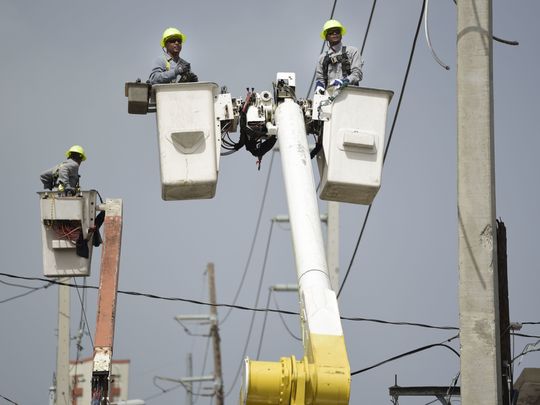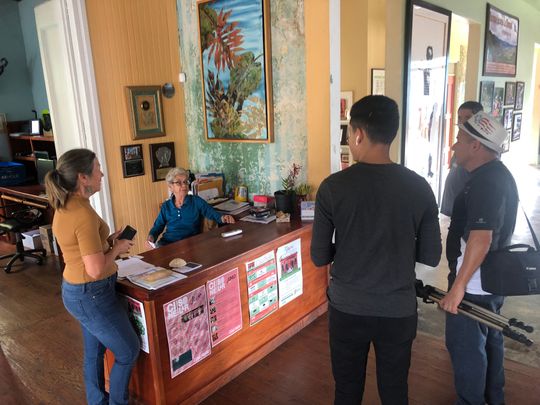 A brigade from the Electric Power Authority repairs distribution lines damaged by Hurricane Maria in the Cantera community of San Juan, Puerto Rico, on Oct. 19, 2017. (Photo: Carlos Giusti, AP)
A brigade from the Electric Power Authority repairs distribution lines damaged by Hurricane Maria in the Cantera community of San Juan, Puerto Rico, on Oct. 19, 2017. (Photo: Carlos Giusti, AP)
ADJUNTAS, Puerto Rico – Visitors to Casa Pueblo, a community center in this mountain hamlet, can tour the solar-powered meeting rooms, listen in on the solar-powered radio station or catch a documentary at the solar-powered movie theater. Later, they could lunch at one of Puerto Rico’s first fully solar-powered restaurants just down the street.
On an island gripped by energy anxiety, Casa Pueblo is a calming oasis.
“This is the model we want for the rest of the (island),” said Alexis Massol-Gonzalez, founding director of Casa Pueblo, a community center and renewables advocacy group. “It would be an energy revolution.”
Hurricane Maria blasted through Puerto Rico on Sept. 20, 2017, battering the island’s outdated power grid and knocking out electricity in parts of the U.S. commonwealth for nearly a year. The lack of power has been a major challenge for Puerto Ricans recovering from the storm and was a key factor in widespread fatalities after the hurricane. The death toll from the storm is 2,975, based on estimates from a study by George Washington University researchers.
Officials everywhere have grappled with how to quickly restore power after a major storm. Teams of utility workers were still working this week in the Florida Panhandle to restore power to hundreds of thousands of customers left powerless by the 155 mph sustained winds of Hurricane Michael this month. Tens of thousands of homes have already regained power at a pace that has surprised some observers.
But in Puerto Rico, restoring power has been a slower, much bigger project that entails, in many cases, completely rebuilding what was a fragile system to begin with. Federal officials have spent more than $3 billion to end the longest blackout in U.S. history and return the Puerto Rican power grid to pre-storm conditions. Now comes the long, tough task of improving the system – at a cost of billions of more federal dollars – to avoid future massive blackouts. How the grid is rebuilt will be a key question in Puerto Rico’s recovery from Maria.
Puerto Rican officials have estimated it will take an additional $26 billion to upgrade the island’s energy grid, though that money has not been approved by Washington.
“There are a lot of temporary patches that have been done,” said Sergio Marxuach, public policy director at the Center for a New Economy, a San Juan-based economic think tank. “It’s functional, but the work on the permanent fix has not started yet.”
 Visitors to Casa Pueblo, a self-sufficient solar-powered community center in Adjuntas, Puerto Rico, can visit the solar-powered radio station or catch a movie at the solar-powered movie theater. (Photo: Rick Jervis)
Visitors to Casa Pueblo, a self-sufficient solar-powered community center in Adjuntas, Puerto Rico, can visit the solar-powered radio station or catch a movie at the solar-powered movie theater. (Photo: Rick Jervis)
At the center of the island’s grid rebuild effort is what to do with the Puerto Rico Electric Power Authority, or PREPA, an agency racked by allegations of corruption and $9 billion in debt. Gov. Ricardo Rossello has proposed privatizing parts of the electrical system, including its oil-powered generation plants. Other suggestions include switching the system to natural gas.
But these plans don’t include a clear path to renewable energy sources, leaving the system vulnerable to future storms, said Cathy Kunkel, an analyst with the Cleveland-based Institute for Energy Economics and Financial Analysis, who co-wrote a July study on this issue. An improved power grid in Puerto Rico should include “microgrids,” or clusters of customers around the island who could disconnect from the larger system if a storm hits and generate power on their own, she said. That strategy would begin to shift the power grid away from its reliance on oil and toward renewables.
Such a massive shift would be difficult, costly and time-consuming but not impossible, Kunkel said. Lawmakers in Hawaii, an archipelago of 1.4 million residents, passed a series of energy bills three years ago directing the state’s utilities to switch to 100 percent renewable energy resources by 2045.
“Obviously, doing that tomorrow for the whole island (of Puerto Rico) is not going to happen,” she said. “But it’s smart to prioritize investment in that direction, which is not what the government of Puerto Rico is doing.”
Since Maria, some communities have already taken action to seek greater energy independence and push toward renewables, such as solar and wind. Tesla, the high-tech maker of electric cars and other products, has launched more than 11,000 projects across the island, including solar panels on homes.
In Adjuntas, Casa Pueblo has the lead. Massol-Gonzalez founded Casa Pueblo in 1980 to oppose open-pit mining in the nearby mountains. His group won that battle and later morphed into advocates of renewable energy. Using donations and proceeds from sales from local artisans, they purchased a house near the city’s central square and attached 45 solar panels to the roof capable of generating 10 kilowatts of power. In 2002, Massol-Gonzalez won the prestigious Goldman Prize for his environmental advocacy work.
Last year, as Maria pummeled homes, tore off roofs and knocked out power in Adjuntas, Casa Pueblo’s lights remained on, he said. With the area cloaked in darkness, the early 20th-century wood-frame home became a glowing beacon for the community. The center’s radio station, powered by solar panels, remained on air the whole time, broadcasting important updates and tips.
Residents began streaming into the center to plug in cellphones, dialysis machines or small refrigerators holding vital medicines.
“At times, hundreds of people would show up each day,” Massol-Gonzalez said. “They called it an ‘energy oasis.’”
Casa Pueblo secured 14,000 solar lamps in the wake of the storm and distributed them to the community. As of late July, they had helped five homes place solar panels, with the goal of making 30 homes throughout the city solar self-sufficient.
In July, a contingent of U.S. Congress members led by House Minority Leader Nancy Pelosi, D-Calif., on a fact-finding mission to Puerto Rico, made the trek to Adjuntas to meet Massol-Gonzalez and witness Puerto Rico’s fledgling solar trend firsthand.
Though destructive, Maria showed Massol-Gonzalez and the Casa Pueblo staff they could survive even the most brutal meteorological attacks on the island, even if the rest of the island is crippled, he said. It’s a lesson Massol-Gonzalez hopes starts to spread across the island.
“We’re fighting against dependency,” he said. “We know we could make transformative changes.”
https://www.usatoday.com/story/news/2018/10/18/puerto-rico-hurricane-maria-power-restoration-casa-pueblo-solar/1445685002/
